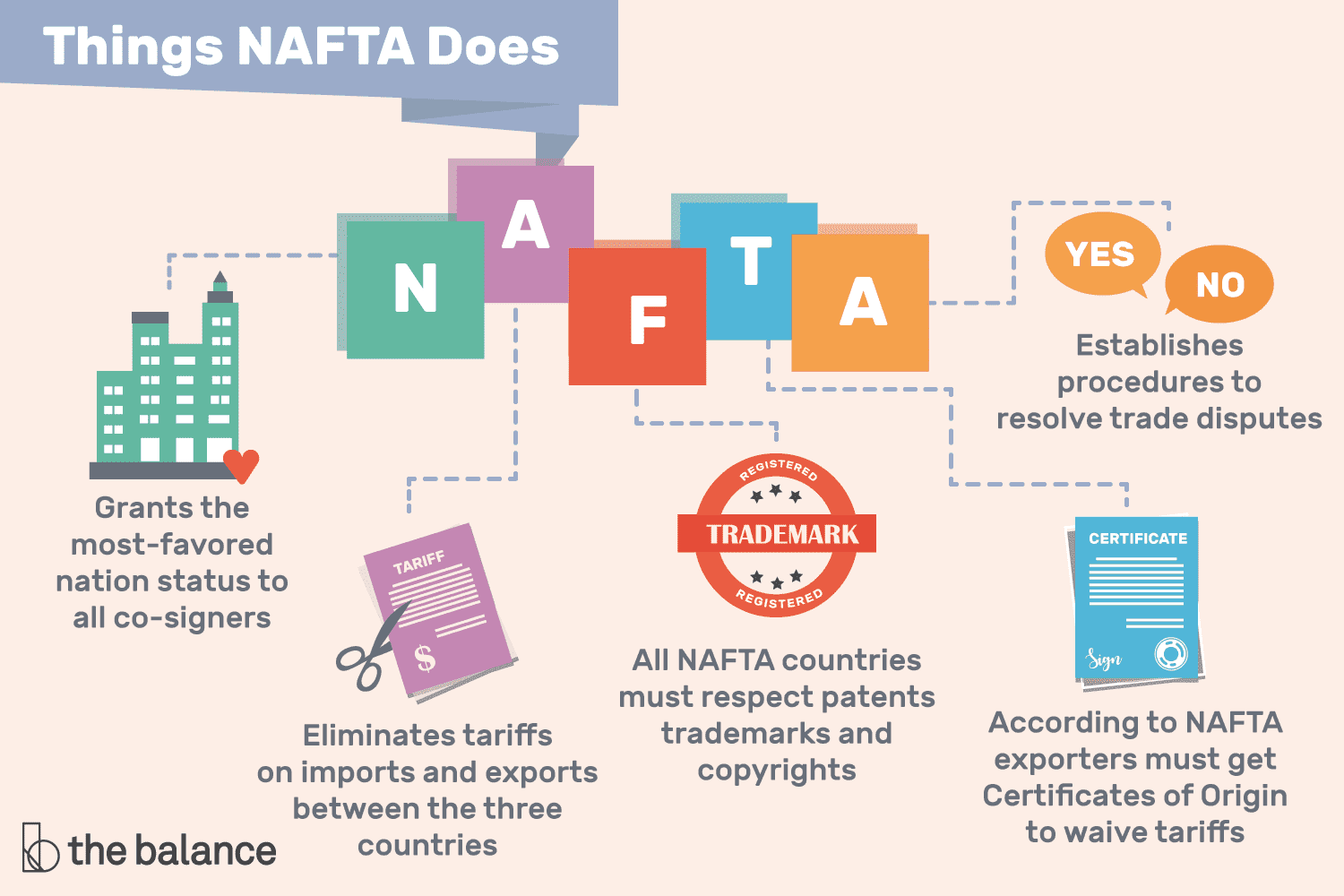Key Takeaways
- The North American Free Trade Agreement (NAFTA) was a treaty between Canada, Mexico, and the United States that eliminated most tariffs among the countries.
- NAFTA was the world’s largest free trade agreement when it entered into force on January 1, 1994.
- In addition to eliminating tariffs, NAFTA accomplished several other things, including granting most-favored-nation status to all countries involved.
- While NAFTA increased trade, critics argued that many US manufacturing jobs moved to Mexico.
- NAFTA was replaced by the United States-Mexico-Canada Agreement (USMCA) on July 1, 2020.
Definition of the North American Free Trade Agreement (NAFTA)
NAFTA was the world’s largest free trade agreement when it was established on January 1, 1994, among Canada, the United States, and Mexico. NAFTA was the first time two developed nations signed a trade agreement with an emerging market country.
Through NAFTA, the three signatories agreed to remove trade barriers between them. By eliminating tariffs, NAFTA increased investment opportunities.
How the North American Free Trade Agreement (NAFTA) Worked
NAFTA accomplished six distinct things for the participating countries. First, NAFTA granted most-favored-nation status to all co-signers. That meant each country treated the other two fairly and couldn’t give better treatment to domestic investors than to foreign ones. They also couldn’t offer a better deal to investors from non-NAFTA countries and had to offer federal contracts to businesses in all three NAFTA countries.
Second, NAFTA eliminated many tariffs on imports and exports among the three countries. Tariffs are taxes that are used to make foreign goods more expensive. NAFTA created specific rules to regulate trade in farm products, automobiles, and clothing, for example.
Third, exporters were required to obtain certificates of origin to waive tariffs. That meant an export had to originate in the United States, Canada, or Mexico. A product made in Peru but shipped from Mexico would still pay a duty when it entered the United States or Canada.
Fourth, NAFTA established procedures to resolve trade disputes. Parties would start with a formal discussion, followed by a discussion at a Free Trade Commission (FTC) meeting if needed. If the disagreement wasn’t resolved, a panel reviewed the dispute.
Note
The trade dispute resolution process helped all parties avoid costly lawsuits in local courts and helped them interpret NAFTA’s complex rules and procedures. These trade-dispute protections applied to investors as well.
Fifth, all three NAFTA countries were required to respect patents, trademarks, and copyrights. At the same time, the agreement ensured that these intellectual property rights did not interfere with trade.
Sixth, the agreement allowed business travelers easy access throughout all three countries.
Pros and Cons of the North American Free Trade Agreement (NAFTA)
Pros Explained
- Lower grocery prices: US grocery prices were lower due to tariff-free imports from Mexico.
- Lower gas prices: Imported oil from both Canada and Mexico prevented higher gas prices.
- Increased trade and growth: Easing tariff restrictions and lower prices on many goods led to increased trade and economic growth for all three countries.
Note
NAFTA increased the competitiveness of these three countries in the global marketplace. It allowed them to compete better with China and the European Union. By per capita GDP on a purchasing power parity basis, China is now the world’s largest economy, having surpassed the United States in 2014.
Cons Explained
- Fewer manufacturing jobs: Some argue that NAFTA had the effect of sending many US manufacturing jobs to lower-cost Mexico.
- Lower wages: US workers who kept jobs in those industries had to accept lower wages.
- Worker exploitation in Mexico: Mexico’s workers suffered terrible labor conditions in its maquiladora programs. A maquiladora is a low-cost, US-owned manufacturing operation or factory operating in Mexico, typically near the Mexico-US border.
Notable Happenings
It took three US presidents to put NAFTA together. President Ronald Reagan kicked it off during his 1979 announcement of his bid for the presidency. He wanted to unify the North American market to compete more effectively.
In 1984, Congress passed the Trade and Tariff Act, which gave the president fast-track authority to negotiate free trade agreements. It permitted Congress only the ability to approve or disapprove, and it couldn’t change negotiating points.
In 1992, President George HW Bush signed NAFTA shortly before he left office. It then went back to the legislatures of all three countries for ratification. In 1993, President Bill Clinton signed it. NAFTA went into effect on January 1, 1994.
On November 30, 2018, the United States, Mexico, and Canada renegotiated NAFTA. The new deal is called the United States-Mexico-Canada Agreement (USMCA). The implementation act passed the House in December 2019 and the Senate in January 2020, and it was signed by President Trump on January 29, 2020. It was ratified in Mexico in June 2019 and in Canada in March 2020. The USMCA went into force on July 1, 2020.
Some of the key differences between NAFTA and the USMCA are:
- A requirement that 75% of auto components are made in North America, an increase from 45% under NAFTA
- A decrease in tariffs and restrictions on products that help American farmers
- Cheaper customs duties and taxes for shipping across borders
Frequently Asked Questions (FAQs)
Was NAFTA bad for the environment?
In Mexico, the changes in agriculture that NAFTA prompted increased the use of chemicals and fertilizers for agriculture, as well as deforestation so farmers could stay in business and stay competitive. These changes degraded the environment.
What is the difference between NAFTA and the EU?
NAFTA was a free trade agreement between the United States, Mexico, and Canada. It was designed to increase economic growth and investment by removing barriers to trade among the three countries. The European Union (EU) is an alliance of European nations that eliminates border controls among member countries. It created a unified monetary system and allowed people and goods to move freely.
